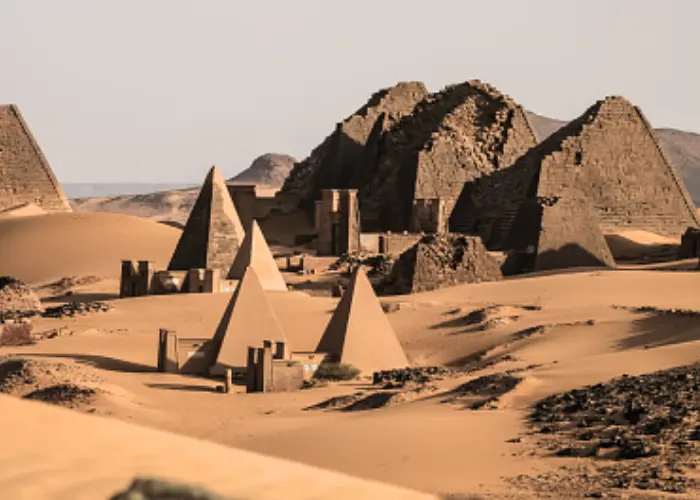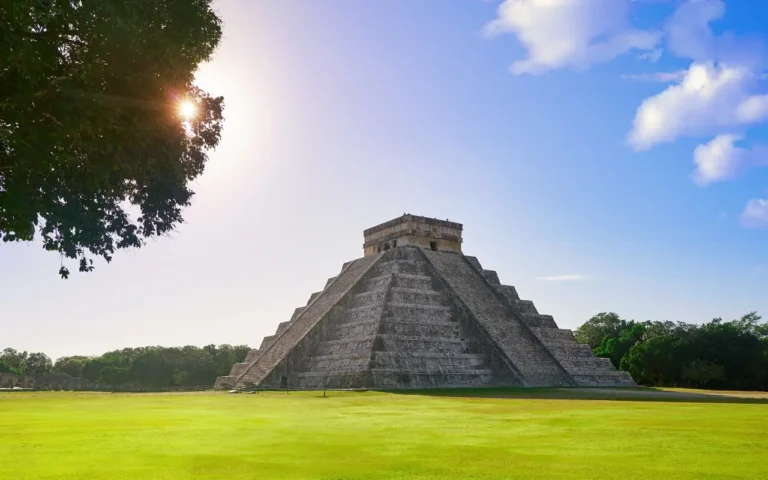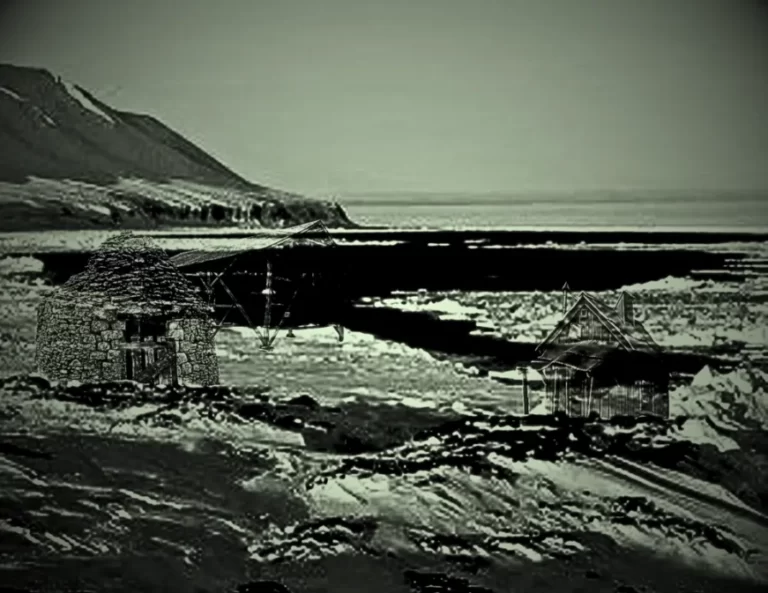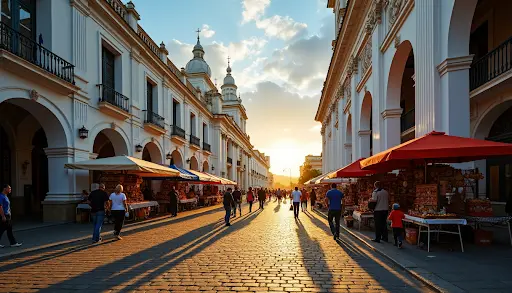Explore the Enigmatic City of Meroe in Sudan – Lost City Found

Moreo, Sudan’s Lost city of pyramids, was Lost in the sands of time for centuries flourishing between 300 BCE and 300 CE. It was the capital of the Kingdom of Kush, an ancient African civilization that was a rival of the Egyptian empire.
It was first mentioned in Greek and Roman texts as a wealthy city that produced iron, ivory, and other luxury goods. However, the location of the city was lost for centuries. European explorers only rediscovered it in the 19th century.
The ruins of Meroe Sudan are located on the east bank of the Nile River, about 200 km northeast of the capital city of Khartoum. The site covers an area of about 30 km and contains more than 200 pyramids and other structures such as temples, palaces, and tombs.
The Sudan Meroe pyramids are decorated with intricate reliefs depicting scenes from daily life, mythology, and religion. The city was also famous for its ironworking industry. Some iron artefacts found at Meroe are considered among the finest examples of ancient ironwork.
It remains relatively unknown to the general public despite its rich history and cultural heritage.
Meroe is not the only lost city that has captured the imagination of scholars and adventurers alike. As you have already read, the ancient city of Atlantis, described by the philosopher Plato in his dialogues, has long been a source of fascination and speculation.
Many of its secrets are still waiting to be uncovered by archaeologists and historians.
Join us on a journey through time as we explore the wonders of Meroe, Sudan’s long-lost city of the sands
The Rise of Moreo, Sudan’s Lost City

Are you ready to explore the captivating history of Meroe, the lost city of Sudan?
It was founded around 800 BCE. Meroe quickly became the region’s important trade, industry, and culture center. Thanks to its strategic location on the Nile River and access to iron deposits in the nearby hills. The city’s reputation for wealth and luxury made it a tempting target for raiders and conquerors. Meroe was sacked and abandoned many times over the centuries. Yet, the ruins of Meroe’s impressive pyramids, among other structures, have been rediscovered recently.
They provide a glimpse into the city’s rich and complex past. These pyramids, located in the desert sands of Sudan, are smaller and steeper than the pyramids of Egypt. They are no less impressive, with intricate reliefs that depict scenes from daily life, mythology, and religion. Meroe is genuinely a lost city found, and its legacy fascinates archaeologists and historians alike.
Meroe’s Unique Culture and Society

Meroe was more than just a trading hub and center of industry. It was also a hub of culture and creativity. The city had a unique culture and society shaped by its history, geography, and interaction with other cultures. The Kingdom of Kush, Meroe’s capital, was known for its sophisticated art, architecture, and religion. The Meroitic language was used in the kingdom’s official inscriptions.
It remains a mystery, with no apparent links to any known language family. A succession of powerful queens ruled the city. Those queens were believed to be divine and oversaw a complex bureaucracy, law, and taxation system. Meroe was also home to a thriving population of craftsmen, merchants, and farmers. They sustained the city’s economy and created a rich and diverse society. Meroe’s unique culture and society may have been lost to the sands of time. But it remains a fascinating and essential part of African history and heritage.
Architecture and Artifacts of Meroe

Meroe’s unique architecture and artefacts illuminate the city’s rich and complex past. The ruins of Meroe’s pyramids were used as tombs for the rulers and nobility of the Kingdom of Kush. Many of them still contain elaborate burial chambers and offerings. The city’s other structures, including temples, palaces, and public buildings, were also built with impressive skill and creativity, with unique features such as round columns and decorative carvings.
In addition to its architecture, Meroe was also known for its sophisticated ironworking industry. It produced some of the finest examples of ancient ironwork ever found. These artefacts, which include weapons, tools, and jewellery, are notable for their intricate designs. Other artefacts found at Meroe include pottery, textiles, and inscriptions written in the Meroitic language.
Archaeologists have been excavating the ruins of Meroe since the early 20th century. Their discoveries have shed new light on the city’s history and culture. Some of the most notable finds include the remains of the palace of Queen Amanishakheto. It was richly decorated with frescoes and mosaics, and the Royal Baths.
Those baths were a complex of rooms and pools for ritual purification and relaxation. The artefacts and structures found at Meroe offer a fascinating glimpse into the city’s unique culture and society, and they continue to inspire new research and discoveries today.
Meroe and the Kingdom of Kush
The relationship between Meroe and the broader Kingdom of Kush was complex and dynamic. A range of factors, including geography, politics, and culture, shapes it.
Initially, the Kingdom of Kush was centred around Napata, further to the north. As the political and economic center of the kingdom shifted southward, Meroe emerged as a significant city and became the capital. Despite this shift, the Kingdom of Kush remained a decentralized society with a diverse population and political and cultural influences.
External factors also shaped the relationship between Meroe and the broader Kingdom of Kush. Such as the interactions with neighbouring civilizations such as Egypt, Rome, and the Axumite Empire. The Kingdom of Kush was known for its military prowess.
Its armies were often engaged in conflict with neighbouring states. At the same time, the kingdom was also a center of trade and commerce. Its strategic location on the Nile River made it an important hub for exchanging goods and ideas. The legacy of Meroe and the Kingdom of Kush fascinates scholars and researchers today.
The Decline and Abandonment of Meroe

Despite its long and illustrious history, Meroe eventually declined and was abandoned in the 4th century CE. The reasons for this decline still need to be fully understood. Yet several factors are believed to have contributed to the city’s eventual abandonment.
One factor was the rise of the Kingdom of Aksum, a powerful civilization in Ethiopia and Eritrea. The Kingdom of Aksum grew in power and influence in the centuries following the decline of Meroe. Its armies are believed to have played a role in the eventual abandonment of the city.
Another factor was the decline in the use of the Meroitic language, which was replaced by Greek and later by Coptic. This shift may have contributed to a loss of cultural identity and cohesion. It may also have contributed to a decline in the city’s fortunes.
Finally, environmental factors may have played a role in the decline of Meroe. The region experienced a period of prolonged drought and environmental degradation. This may have made it more difficult for the city to sustain itself and its population.
Despite the decline and abandonment of Meroe, the city’s legacy continues to inspire scholars and researchers today. The city’s ruins offer a fascinating glimpse into the culture and society of the Kingdom of Kush.
The story of Meroe and the broader Kingdom of Kush is a testament to the resilience and creativity of African civilization. It is also a reminder of the vital role that these civilizations have played in shaping the world we live in today.







Greetings! Very useful advice within this article! Its the little changes that make the most significant changes. Thanks a lot for sharing!